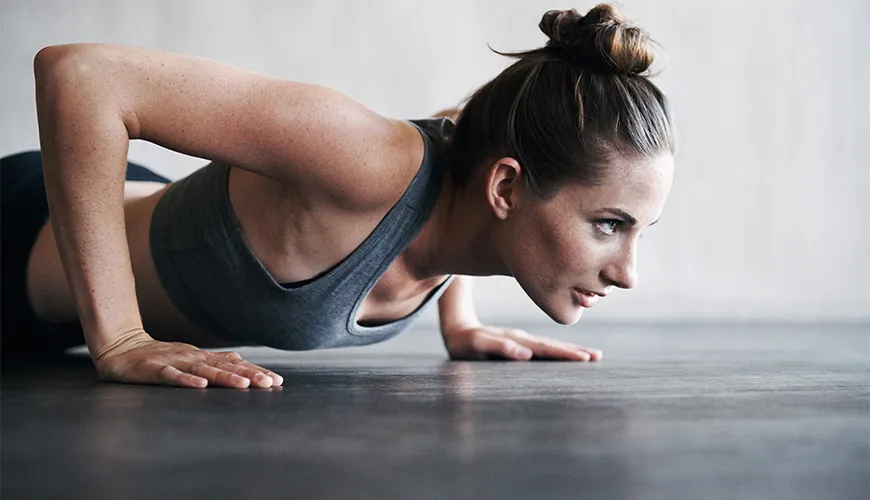1. Morning Stretching Routine to Wake Up Your Body
Starting your day with a quick stretching session is one of the simplest yet most effective fitness routines for busy people. Just five to ten minutes of stretching each morning can loosen stiff muscles, improve circulation, and mentally prepare you for the day ahead. Stretching wakes up your nervous system, relieves overnight tension, and improves flexibility over time. A simple routine could include touching your toes, side stretches, shoulder rolls, and neck stretches. None of these movements require equipment, making them perfect for people with tight schedules. Incorporating stretches at the beginning of the day can also prevent stiffness caused by long hours at a desk. The beauty of stretching is that it doubles as both a physical and mental warm-up, helping you feel energized before diving into work or daily responsibilities. Over time, this small habit enhances posture, reduces the risk of injury, and builds consistency in your fitness journey without overwhelming your schedule.
2. Desk Workouts During Office Hours
Busy professionals often feel they don’t have time for exercise, but desk workouts are proof that fitness can be integrated into your workday. These are simple movements you can perform while seated or standing near your desk, such as seated leg lifts, chair squats, or desk push-ups. You can also do calf raises while on calls or seated torso twists to engage your core. These micro-workouts improve blood flow, reduce stiffness, and keep energy levels steady throughout the day. They also counteract the negative effects of prolonged sitting, which is linked to back pain and poor circulation. Even a few minutes every hour can accumulate into significant benefits. With desk workouts, you don’t have to choose between productivity and health—you can achieve both simultaneously. This approach also encourages discipline, proving that small, consistent actions matter more than long, infrequent gym sessions.
3. Lunchtime Power Walks for Daily Cardio
Cardio doesn’t always have to involve treadmills or long runs. A brisk 20- to 30-minute walk during lunch can be a powerful way to fit cardio into a busy day. Walking improves cardiovascular health, burns calories, and reduces stress—all without special equipment. For office workers, it’s also an excellent way to get fresh air and reset your mind before returning to work. Walking meetings are another creative option that blend productivity with movement. Over time, these daily walks improve stamina, support weight management, and reduce the risk of lifestyle diseases such as diabetes or hypertension. Unlike high-intensity routines, walking is sustainable, accessible, and easy to adapt to any schedule. Even if your day is filled with deadlines, dedicating your lunch break to movement ensures that fitness becomes a consistent part of your routine rather than an afterthought.
4. Ten-Minute High-Intensity Interval Training (HIIT) Sessions
For people who feel there’s absolutely no time for fitness, high-intensity interval training is a game-changer. HIIT involves short bursts of intense activity followed by brief rest periods, allowing you to burn calories and boost metabolism in as little as ten minutes. For example, alternating 30 seconds of jumping jacks with 30 seconds of rest, repeated for ten minutes, can deliver a powerful workout. HIIT increases cardiovascular fitness, builds endurance, and continues burning calories even after the workout ends. The short duration makes it easy to fit into a morning routine, work break, or even before bed. Since no equipment is required for many HIIT exercises, it eliminates excuses about space or cost. This type of training is especially valuable for busy individuals who want maximum results in minimum time.
5. Evening Yoga for Relaxation and Flexibility
At the end of a hectic day, yoga provides both physical and mental restoration. Just 15–20 minutes of yoga in the evening can stretch tight muscles, improve flexibility, and release stress accumulated throughout the day. Simple poses such as child’s pose, downward dog, or cat-cow can relieve back tension from sitting and promote relaxation. Yoga also enhances balance, posture, and breathing awareness. Beyond the physical benefits, it encourages mindfulness, helping busy people transition from work mode to a calmer state before sleep. Unlike high-intensity routines, yoga feels restorative rather than draining, making it a sustainable habit. Over time, evening yoga improves sleep quality, strengthens muscles, and supports overall well-being, all while requiring minimal time commitment. For anyone with a demanding schedule, yoga is an accessible way to maintain health while recharging emotionally.
6. Quick Core Workouts That Strengthen Stability
Core workouts don’t require endless crunches or hours at the gym. A simple 10-minute routine of planks, bicycle crunches, and mountain climbers is enough to strengthen the core muscles that support posture and balance. Strong core muscles prevent back pain, improve daily movements, and boost athletic performance. Since these exercises require no equipment, they can be done at home, during breaks, or even in a hotel room while traveling. For busy people, targeting the core is one of the most efficient uses of time because it impacts nearly every physical activity—from sitting upright at a desk to carrying groceries. By dedicating just a few minutes each day to your core, you lay the foundation for long-term health and strength without disrupting your schedule.
7. Resistance Band Workouts for On-the-Go Fitness
Resistance bands are compact, affordable, and versatile tools that allow you to perform strength training anywhere. Busy individuals can keep one in a bag or desk drawer and use it for exercises like bicep curls, lateral raises, or squats. Just 10–15 minutes of resistance band training builds muscle strength, improves endurance, and enhances flexibility. Unlike heavy gym equipment, bands are portable, making them perfect for travel or small spaces. Strength training is essential not only for toning but also for maintaining bone density and metabolism, especially as we age. Resistance band routines are quick to learn, require minimal setup, and are easy to adjust to your fitness level. For someone with a packed schedule, this is one of the simplest ways to integrate strength training into daily life.
8. Stair Climbing as a Natural Workout
Skipping the elevator and taking the stairs is one of the easiest fitness hacks for busy people. Stair climbing engages the legs, glutes, and cardiovascular system, offering a powerful workout in just minutes. It burns more calories than walking on flat ground and improves lower body strength and endurance. Many busy professionals underestimate how much this simple choice adds up over time. Consistently choosing stairs instead of escalators or elevators transforms daily routines into calorie-burning opportunities. It requires no special planning, no equipment, and no extra time carved out of your day—making it one of the most accessible fitness routines. Over time, stair climbing builds stamina, tones muscles, and keeps your heart strong, all while fitting seamlessly into your busy lifestyle.
9. Five-Minute Breathing and Posture Breaks
Fitness is not just about movement—it’s also about awareness. Taking a few minutes every couple of hours to check your posture and practice deep breathing can make a big difference. Sitting hunched over for hours causes stiffness and back problems, but simply rolling your shoulders back, stretching the spine, and breathing deeply for five minutes restores energy and focus. Breathing exercises also lower stress hormones, improve oxygen flow, and calm the mind. This practice enhances both physical health and productivity, making it ideal for busy people who can’t afford long workouts. By combining posture correction with mindful breathing, you address both body and mind fitness, creating a habit that’s simple, effective, and time-efficient.
10. Weekend Activity Swaps for Family Fitness
Even if weekdays are overloaded, weekends can provide fitness opportunities that double as family bonding time. Instead of spending the entire weekend indoors, choose active outings such as cycling, hiking, or playing sports with family or friends. These activities burn calories, strengthen muscles, and improve cardiovascular health—all while creating memories. Busy people often neglect exercise during weekdays, but weekend routines can make up for it. The key is to choose enjoyable activities that don’t feel like workouts, ensuring consistency. By turning leisure time into active time, you reinforce fitness as part of your lifestyle rather than a chore. Over time, weekend activity swaps create balance, reduce stress, and provide both physical and emotional rewards.
11. Bodyweight Circuits for Total Strength
For people without access to a gym, bodyweight exercises like push-ups, squats, lunges, and planks provide full-body strength training. A circuit of these exercises performed for just 15 minutes delivers results comparable to longer sessions. Bodyweight training improves muscle tone, endurance, and balance without requiring equipment or setup. These exercises can be done at home, in a hotel room, or even outdoors, making them highly adaptable to busy lifestyles. Circuits can be customized to your time limits, ensuring that even the busiest person can squeeze in a workout. The simplicity of bodyweight routines makes them sustainable, and their effectiveness builds confidence in your ability to stay fit regardless of schedule.
12. Micro-Workouts Between Tasks
One of the most innovative approaches for busy people is breaking workouts into small chunks throughout the day. Instead of a single 30-minute session, you can do three 10-minute workouts at different times. These micro-workouts could include jumping jacks in the morning, squats during lunch, and push-ups before dinner. Research shows that breaking activity into smaller sessions is just as effective for health benefits as one longer workout. This method is particularly helpful for parents, entrepreneurs, or professionals with unpredictable schedules. Micro-workouts remove the excuse of “no time,” proving that fitness can be integrated into your day in flexible ways. Over time, these small bursts accumulate into significant improvements in strength, stamina, and overall wellness.
13. Walking or Cycling Commutes
Turning commutes into fitness time is another brilliant solution for busy people. Walking or cycling to work, school, or errands integrates exercise into daily routines without requiring additional time. Even partial commuting, such as parking farther away or getting off public transport a stop early, adds valuable steps. Cycling boosts cardiovascular fitness, tones leg muscles, and reduces stress, while walking promotes circulation and burns calories. By transforming necessary travel into movement, you eliminate the barrier of scheduling workouts. This approach also saves money and reduces environmental impact, making it beneficial on multiple levels. For anyone feeling too busy, active commuting proves that fitness and practicality can go hand in hand.
14. Stretch-Before-Bed Routine for Recovery
Before bed, taking just five to ten minutes to stretch helps relax muscles, improve flexibility, and prepare the body for restful sleep. Busy days often leave muscles tight and overworked, and stretching at night prevents stiffness from carrying into the next day. Movements such as hamstring stretches, shoulder stretches, or gentle spinal twists are soothing and restorative. This nighttime ritual not only improves recovery but also signals to the brain that it’s time to wind down, improving sleep quality. For busy people, combining fitness with relaxation ensures that health goals don’t compete with rest. Instead, they complement each other, promoting a balanced lifestyle. Over time, this routine enhances both physical flexibility and mental calmness.
15. Jump Rope for Quick Cardio
Jumping rope is a powerful full-body workout that requires only a few minutes and minimal space. Just five to ten minutes of jump rope daily improves cardiovascular health, coordination, and endurance. It burns calories faster than many other cardio exercises, making it ideal for people who want maximum results in minimum time. A jump rope is inexpensive, portable, and easy to store, making it perfect for busy individuals who lack gym access. This quick workout can be done in the morning before work, during breaks, or even while traveling. Over time, jump rope routines improve agility, strengthen bones, and enhance overall fitness levels. It’s a time-efficient solution that fits seamlessly into hectic schedules.
16. Fitness Apps and Online Workouts
Technology makes fitness easier than ever for busy people. Mobile apps and online platforms provide guided workouts ranging from five minutes to an hour, allowing you to choose routines that fit your schedule. Many apps offer tracking features, reminders, and progress reports, helping you stay accountable even with limited time. Online workouts remove the need for commuting to a gym, saving precious hours. From yoga and pilates to strength training and HIIT, the variety ensures you’ll find something enjoyable. The convenience of having expert-led workouts at your fingertips eliminates excuses and makes it easier to stay consistent. Over time, this digital support system becomes a personal trainer in your pocket.
17. Chores as Functional Workouts
Everyday chores can double as fitness opportunities if approached with intention. Activities like vacuuming, gardening, carrying groceries, or even cleaning windows engage multiple muscle groups and burn calories. By increasing intensity—such as squatting while picking things up or briskly sweeping—you can turn routine tasks into mini-workouts. This approach is particularly helpful for parents or homemakers who struggle to carve out gym time. Functional workouts improve strength and flexibility while completing necessary daily tasks. By reframing chores as opportunities for movement, busy individuals can achieve fitness goals without additional scheduling. Over time, these small efforts accumulate into noticeable improvements in strength, stamina, and calorie burn.
18. Mini Meditation and Movement Combos
Fitness is not just about the body—it’s also about the mind. Combining short meditation with light movement creates a routine that boosts both mental and physical well-being. For example, five minutes of deep breathing followed by five minutes of stretching or yoga creates a balanced, refreshing break. This practice reduces stress, improves focus, and enhances flexibility. For busy people, it’s a way to recharge energy without needing long sessions. Mini meditation and movement combos prove that fitness doesn’t always mean sweat—it can also mean balance and restoration. This habit nurtures a healthier relationship with exercise, making it easier to sustain long term.
19. Weekend Meal Prep with Active Breaks
While meal prep is usually linked to nutrition, it can also incorporate fitness. Taking active breaks while cooking—such as doing squats while waiting for water to boil or lunges between chopping vegetables—keeps you moving. Busy people often struggle to find time for both meal planning and workouts, so combining the two is efficient. This approach builds consistency, ensuring you stay active even during tasks that would otherwise keep you sedentary. It also reinforces the link between healthy eating and fitness, creating a holistic wellness routine. Over time, these active meal prep habits save time, promote healthier eating, and improve overall fitness levels.
20. Prioritizing Consistency Over Intensity
Finally, the secret to fitness for busy people is consistency. It’s not about doing the hardest or longest workout but about building habits that stick. Even 10 minutes of daily movement is better than occasional intense sessions. Consistency rewires your brain, making fitness an automatic part of your lifestyle. For busy individuals, this means choosing routines that are realistic and sustainable rather than overwhelming. Over time, small but regular actions lead to significant transformations in strength, endurance, and overall health. By prioritizing consistency, you ensure that fitness becomes a lifelong practice rather than a temporary challenge.
✅ Conclusion
Fitness doesn’t require hours at the gym or complicated routines. For busy people, simple strategies—like stretching, walking, bodyweight exercises, or using daily activities—are more than enough to stay healthy. The key is building habits that fit naturally into your lifestyle so that movement becomes part of your day instead of another task on your to-do list. With these 20 simple routines, anyone, no matter how busy, can achieve better health, more energy, and a stronger body.




Sign up